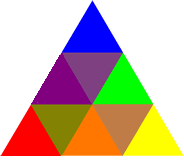Please note: some links on this page are in maintenance.
About the Piece
From about 1790 to about 1810 the poet Wolfgang Goethe worked on the science of light and colour. The resulting Theory of Colour (1810) consisted of three sections: a ‘didactic’ section on the experimental science, a ‘polemic’ section intended to dethrone Newtonian orthodoxy, and , most interestingly, a ‘historical’ section on theories of colour since the pre-Socratics.

Should your glance on mornings lovely
Lift to drink the heaven’s blue
Or when sun, veiled by sirocco,
Royal red sinks out of view –
Give to Nature praise and honour.
Blithe of heart and sound of eye,
Knowing for the world of colour
Where its broad foundations lie.

from Serene.
![]()
of the human mind and he linked each color with certain emotions. For example, Goethe associated blue with understanding and believed it evoked a quiet mood, while he believed that red evoked a festive mood and was suggestive of imagination.
(http://www.cs.brown.edu/courses/cs092/VA10/HTML/)

Using Goethe’s triangle or pyramid as a starting point the American artist and educator Josef Albers developed an experimental way of studying and teaching colour . His book Interaction of Color (Yale University Press 1974) puts practice before theory and aims to help the artist develop a sensitivity for colour leading to an awareness of the interdependence of colour with form and shape. To achieve this Albers assembles a collection of exercises which require little but coloured paper and a pair of scissors.
What Albers is doing is helping the student artist learn for him or herself about the affect of colour, its sensation; what the eye sees when particular colours and shapes come together. Such experience can then form the basis of a personal vocabulary or practice that the artist can use within their own artistic vision.
Albers teased out from Goethe’s triangle a series of colour relationships that had particular expressive characteristics; he gave these names: Lucid, Serious, Mighty, Serene, Melancholic. It is these names that have provided the titles for The Goethe Triangle. They describe particular groupings of colour that seem to contain the essence of particular emotional or psychological states. They provide a rich starting point for a musical invention linked to aspects of both colour and communication. (Nigel Morgan. Introduction to Conversations in Colour BBC Wales 2001).

The remote three ensembles in the premiere of Conversations in Colour.
About the Music
The Goethe Triangle is a five movement work for solo piano lasting about 12 minutes. It has been realised from the composer’s inter-performance Conversations in Colour commissioned by BBC Wales for a major
digital arts event devised by BBC Wales called Platfform 2001. The original composition was a triangular exchange of sounds, visuals and music devised by Nigel Morgan and digital artist Jo Hyde. It was produced by Andrew Burke and Jeremy Garside of RESOUND, the education and community department of the BBC National Orchestra of Wales.

from Lucid.
![]()

from Mighty.
![]()
A Guide to Performance
Tempo, dynamics and articulation indicated should be considered as a guide, no more. There are a number of opportunities for the use of the third pedal when available. The use of amplification and signal processing of the piano where possible would be very much in the spirit of this work, particularly in the movements Lucid, Mighty and Serene.
Downloads
Full score [pdf]
Reference Recording [mp3]
To find out more about Conversations in Colour, click here.
